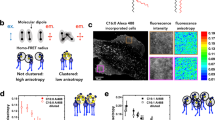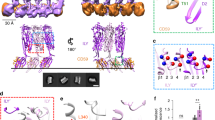Abstract
CHOLERA toxin, a protein of molecular weight 84,000, comprising five or six B and one A subunits, produces massive diarrhoea in man and other mammals by altering the transport of salt and water across the intestinal epithelium1–4. These effects are mediated by a sequence of events leading to an increase in the concentration of cyclic AMP in the epithelial cells. The sequence involves binding of the toxin through its B subunits to specific receptors which seem to be the mono-sialoganglioside galactosyl-N-acetyl-galactosaminyl-(N-acetyl-neuraminyl)-galactosyl-glucosyl-ceramide (GM1), and subsequent activation of adenyl cyclase5–7. We report here experiments which show that cholera toxin reacts with lipid bilayers containing GM1 to form channels which allow ions present in the aqueous solution to traverse the membrane.
This is a preview of subscription content, access via your institution
Access options
Subscribe to this journal
Receive 51 print issues and online access
$199.00 per year
only $3.90 per issue
Buy this article
- Purchase on Springer Link
- Instant access to full article PDF
Prices may be subject to local taxes which are calculated during checkout
Similar content being viewed by others
References
Finkelstein, R. A. Crit. Rev. Microbiol. 2, 533–623 (1973).
Klapper, D. G., Finkelstein, R. A. & Capra, J. D. Immunochemistry 13, 605–611 (1976).
Gill, D. M. & King, C. A. J. biol. Chem. 250, 6424–6432 (1975).
Gill, D. M. Biochemistry 15, 1242–1248 (1976).
Cuatrecasas, P. Biochemistry 12, 3547–3558 (1973).
Holmgren, J., Lönroth, I. & Svennerholm, L. Infect. Immun. 8, 208–241 (1973).
Fishman, P. H. & Brady, R. O. Science 194, 906–915 (1976).
Montal, M. & Mueller, P. Proc. natn. Acad. Sci. U.S.A. 69, 3561–3566 (1972).
Hall, J. E. & Latorre, R. Biophys. J. 15, 99–103 (1976).
Author information
Authors and Affiliations
Rights and permissions
About this article
Cite this article
TOSTESON, M., TOSTESON, D. Bilayers containing gangliosides develop channels when exposed to cholera toxin. Nature 275, 142–144 (1978). https://doi.org/10.1038/275142a0
Received:
Accepted:
Published:
Issue Date:
DOI: https://doi.org/10.1038/275142a0
This article is cited by
-
Calcium transport affinity, ion competition and cholera toxin effects on cytosolic Ca concentration
The Journal of Membrane Biology (1987)
-
Complexity of the influence of gangliosides on histamine release from human basophils and rat mast cells
Agents and Actions (1987)
Comments
By submitting a comment you agree to abide by our Terms and Community Guidelines. If you find something abusive or that does not comply with our terms or guidelines please flag it as inappropriate.



